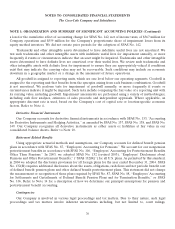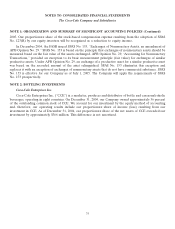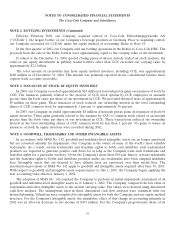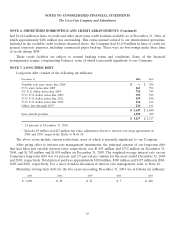Coca Cola 2004 Annual Report Download - page 81
Download and view the complete annual report
Please find page 81 of the 2004 Coca Cola annual report below. You can navigate through the pages in the report by either clicking on the pages listed below, or by using the keyword search tool below to find specific information within the annual report.NOTES TO CONSOLIDATED FINANCIAL STATEMENTS
The Coca-Cola Company and Subsidiaries
NOTE 2: BOTTLING INVESTMENTS (Continued)
Effective February 2002, our Company acquired control of Coca-Cola Erfrischungsgetraenke AG
(‘‘CCEAG’’), the largest bottler of our Company’s beverage products in Germany. Prior to acquiring control,
our Company accounted for CCEAG under the equity method of accounting. Refer to Note 18.
In the first quarter of 2002, our Company sold our bottling operations in the Baltics to Coca-Cola HBC. The
proceeds from the sale of the Baltic bottlers were approximately equal to the carrying value of the investment.
If valued at the December 31, 2004, quoted closing prices of shares actively traded on stock markets, the
value of our equity investments in publicly traded bottlers other than CCE exceeded our carrying value by
approximately $2.2 billion.
The total amount of receivables due from equity method investees, including CCE, was approximately
$680 million as of December 31, 2004. This amount was primarily reported in our consolidated balance sheet
caption trade accounts receivable.
NOTE 3: ISSUANCES OF STOCK BY EQUITY INVESTEES
In 2004, our Company recorded approximately $24 million of noncash pretax gains on issuances of stock by
CCE. The issuances primarily related to the exercise of CCE stock options by CCE employees at amounts
greater than the book value per share of our investment in CCE. We provided deferred taxes of approximately
$9 million on these gains. These issuances of stock reduced our ownership interest in the total outstanding
shares of CCE common stock by approximately 1 percent to approximately 36 percent.
In 2003, our Company recorded approximately $8 million of noncash pretax gains on issuances of stock by
equity investees. These gains primarily related to the issuance by CCE of common stock valued at an amount
greater than the book value per share of our investment in CCE. These transactions reduced our ownership
interest in the total outstanding shares of CCE common stock by less than 1 percent. No gains or losses on
issuances of stock by equity investees were recorded during 2002.
NOTE 4: GOODWILL, TRADEMARKS AND OTHER INTANGIBLE ASSETS
In accordance with SFAS No. 142, goodwill and indefinite-lived intangible assets are no longer amortized
but are reviewed annually for impairment. Our Company is the owner of some of the world’s most valuable
trademarks. As a result, certain trademarks and franchise rights to bottle and distribute such trademarked
products are expected to generate positive cash flows for as long as the Company owns such trademarks and
franchise rights for a particular territory. Given the Company’s more than 100-year history, certain trademarks
and the franchise rights to bottle and distribute products under our trademarks have been assigned indefinite
lives. Intangible assets that are deemed to have definite lives are amortized over their useful lives. The
amortization provisions of SFAS No. 142 apply to goodwill and intangible assets acquired after June 30, 2001.
With respect to goodwill and intangible assets acquired prior to July 1, 2001, the Company began applying the
new accounting rules effective January 1, 2002.
The adoption of SFAS No. 142 required the Company to perform an initial impairment assessment of all
goodwill and indefinite-lived intangible assets as of January 1, 2002. The Company compared the fair value of
trademarks and other intangible assets to the current carrying value. Fair values were derived using discounted
cash flow analyses. The assumptions used in these discounted cash flow analyses were consistent with our
internal planning. Valuations were completed for intangible assets for both the Company and our equity method
investees. For the Company’s intangible assets, the cumulative effect of this change in accounting principle in
2002 was an after-tax decrease to net income of $367 million. For the Company’s proportionate share of its
79
























